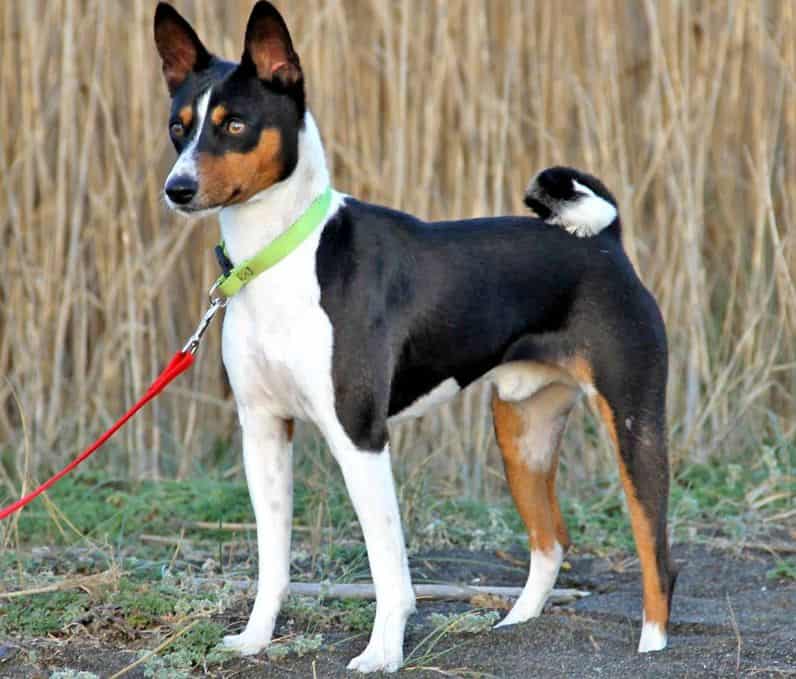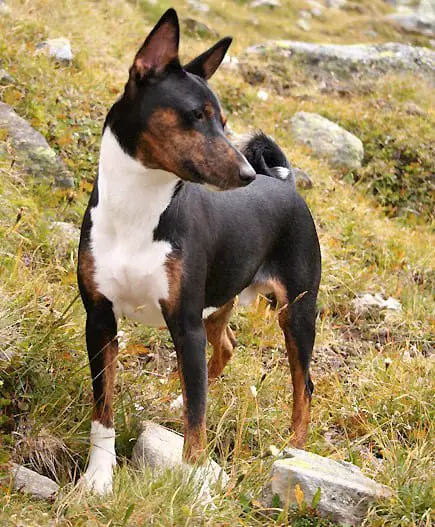The Basenji is an ancient dog breed that was previously used for hunting. They have the nickname “the barkless dog” because the shape of their larynx does not allow them to produce the same barking noise that most people associate with dogs. The Basenji does, however, make a very distinctive yodeling sound. This affectionate dog would happily spend all day “talking” to their people using these yodels!
The loveable, friendly, and intelligent Basenji leaves an impression on anyone who sees them. Their striking pointy ears and thin, muscled appearance are absolutely unforgettable. If you’ve seen this dog before, you likely remember it for its bright red coloring.
You may be surprised to learn that the Basenji comes in several different colors and can have several types of markings. These pups have a surprising amount of variety in their coats, which gives prospective owners a lot of choice when picking out a puppy.
Keeping track of the different colors of the Basenji can be quite confusing. There are some discrepancies between what is allowed by breed groups, what is allowed by the AKC, and what colors occur in Basenjis in the wild. Keep reading to learn more about Basenji colors!
AKC Standard Basenji Colors
1. Red And White
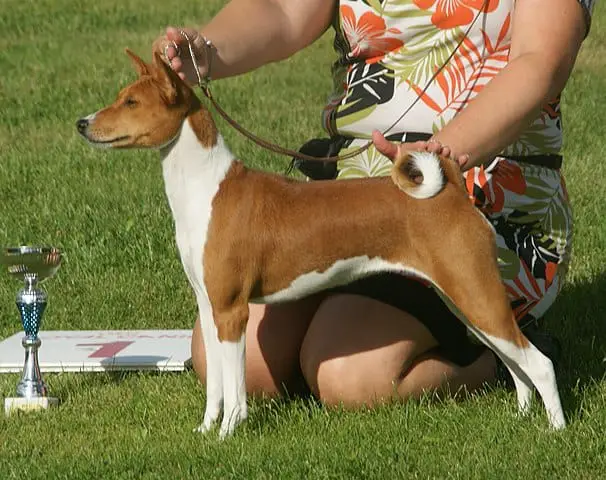
This is the first color combination most people think of when they think of the Basenji. Some people unfamiliar with the breed mistake this for an orange, but the distinctive red color is actually known as “chestnut”.
There should be distinct separations between the chestnut and white areas of fur (so one should not bleed into the other).
According to the American Kennel Club (AKC), the Basenji should have “white feet, chest and tail tip.” However, they state that white legs, blaze, and collar are optional. This is true for all Basenji with white markings in the AKC.
The AKC also states that the amount of white should never be more than the amount of the primary color. This is why when you see a Basenji, you normally remember their chestnut coloring!
2. Black And White
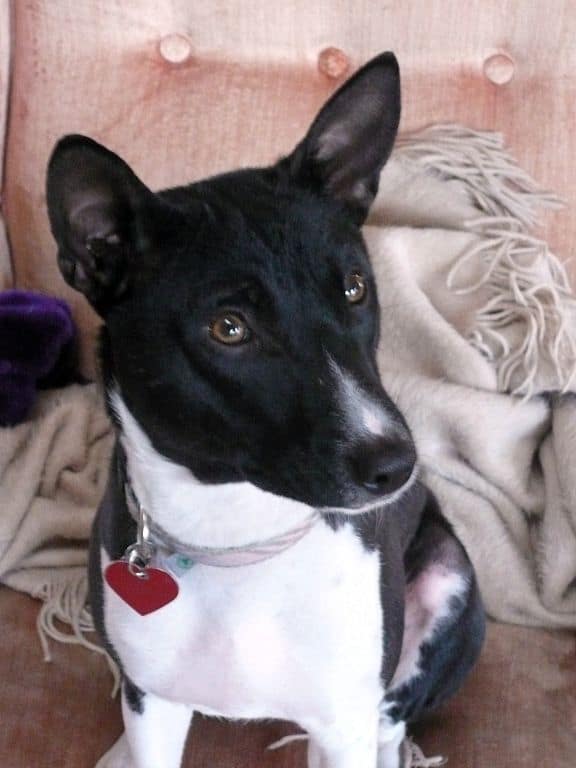
This next AKC-recognized standard color combination: Black & White, is slightly less common than the well-known chestnut and white. However, we think it is absolutely gorgeous! The same rules for white markings apply to the black and white Basenji. However, this coloration tends to be less discussed.
The black should be a pure, deep, glossy black, which shows a striking contrast against the white markings. This glossy black becomes even more pronounced when you see the Basenji in the sun where their coat can really shine!
3. Tri-Color (Black, Chestnut, and White)
This is the third of the standard colorations for the AKC. As the name suggests, tri-colored Basenjis are actually a combination of black, chestnut, and white.
Typically, these Basenjis will be mostly black with chestnut faces and inner ears. They also may have some chestnut markings on their legs and paws. According to the AKC, there should be a “distinct line of demarcation between the black and red of tricolors.”
This color is very interesting in that it is a recessive trait. If you’re looking for a Basenji puppy that has this unique appearance, you should look for a puppy that’s descended from two tri-colored parents! Two parents with the gene responsible for this coloration are guaranteed to produce puppies that also exhibit this trait.
Non-Standard Basenji Colors
4. Trindle
While this is a less common color, it is really amazing to look at! Trindle is a combination of the words “tri-colored” and “brindle.”
Trindle is another version of tri-coloring, but with an interesting twist. Instead of having smaller chestnut markings, the trindle Basenji has small brindle markings. The stunning dark brindle muzzle and ears give the trindle Basenji quite a unique appearance!
5. Cream And White
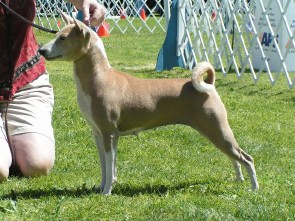
This coloration was quite common in Basenjis when they were first imported to the United States. Instead of the red that most people have come to know and love today, the Basenji used to be pale yellow.
Because the cream color was selectively bred out, it is much less common today than it used to be. There are very few reports of it occurring even in Africa (where these dogs originate).
However, recently this color seems to be making a bit of a comeback among certain breeders!
6. Sable And White
“Sable” might sound like a super unusual color, but it is one that every dog enthusiast has seen before! This color occurs when the red in the red and white Basenji is tipped with black. This gives a whole new look to the typical coat.
To give you a better picture of what this color looks like, this is the same as the standard “sesame” color commonly seen in Shiba Inus. It is a stunning variation of the red and white Basenji that is sure to stop any onlooker in their tracks!
7. Mahogany And White
Mahogany Basenjis are also red but have a much deeper color than the standard chestnut. This can be attributed to more black being present in the red portions of mahogany and white Basenjis.
This coloration is possibly the rarest one today and they’re not easy to find at breeders or shelters.
It used to be the case that the only available pictures of them were in black and white, but thanks to Instagram, I did manage to find a picture of this beautiful dog!
Final thoughts: Which Basenji Color is right for you?
Unlike many other dog breeds, neither the parent club nor the AKC is too strict on the coloration of the Basenji. While there are four standard colors, non-standard colors do not eliminate them from the show ring
In fact, breeders and Basenji enthusiasts have been pushing for the inclusion of more non-standard colors in dog shows. While many of these stunning colors – such as cream and white – were selectively bred out, it seems like they are making a comeback!
No matter the color, Basenjis are excellent dogs, but the fact that there are so many coat variations does mean that prospective owners have a bit more choice on how they want their dog to look.
If you are considering a Basenji puppy, be sure to only purchase from a reputable breeder. This will help to ensure you get the healthiest, happiest puppy possible.
- How Long Do American Eskimo Dogs Live? Important Factors and Care Tips - September 29, 2023
- Do American Bulldogs Need Grooming? Essential Tips and Care Guidelines - September 29, 2023
- Do Bengal Cats Enjoy Playing? Essential Tips for Keeping Them Active - September 29, 2023
